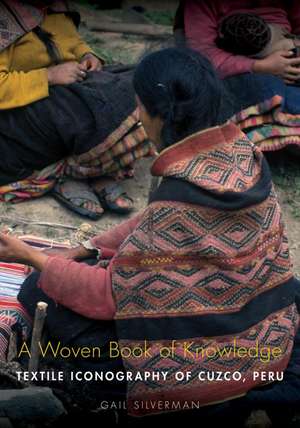A Woven Book of Knowledge: Textile Iconography of Cuzco, Peru
Autor Gail P Silvermanen Limba Engleză Paperback – 29 oct 2008 – vârsta ani
Known for their intricate textiles, the Q’ero are a traditional Quechua-speaking Peruvian highland people. Their weavings are full of symbolic elements and motifs that encode specific cultural information and their textiles are the repositories for knowledge that has been passed down through generations.
Based on ethnographic fieldwork undertaken between 1979 and 1991, A Woven Book of Knowledge examines and compares regional weaving styles and discusses the general texture of highland life.
The author’s long involvement with members of the Q’ero community has provided unique opportunities for insight into their ideas about weaving, iconography, and spatial and temporal concepts. But A Woven Book of Knowledge is more than an ethnographic study. If the warp of the book is the academic rigor of anthropology and linguistics, the weft is Silverman’s love for the textiles themselves and for the Q’ero people. It is a result of a passion that has kept her in Cuzco for years, dedicating her career to the study of the local textile tradition.
Based on ethnographic fieldwork undertaken between 1979 and 1991, A Woven Book of Knowledge examines and compares regional weaving styles and discusses the general texture of highland life.
The author’s long involvement with members of the Q’ero community has provided unique opportunities for insight into their ideas about weaving, iconography, and spatial and temporal concepts. But A Woven Book of Knowledge is more than an ethnographic study. If the warp of the book is the academic rigor of anthropology and linguistics, the weft is Silverman’s love for the textiles themselves and for the Q’ero people. It is a result of a passion that has kept her in Cuzco for years, dedicating her career to the study of the local textile tradition.
Preț: 205.87 lei
Preț vechi: 332.75 lei
-38% Nou
Puncte Express: 309
Preț estimativ în valută:
39.39€ • 41.25$ • 32.67£
39.39€ • 41.25$ • 32.67£
Carte indisponibilă temporar
Doresc să fiu notificat când acest titlu va fi disponibil:
Se trimite...
Preluare comenzi: 021 569.72.76
Specificații
ISBN-13: 9780874809091
ISBN-10: 0874809096
Pagini: 248
Ilustrații: 32 color photos, 106 b-w illus., 8 tables, 2 maps
Dimensiuni: 178 x 229 x 18 mm
Greutate: 0.54 kg
Ediția:1st Edition
Editura: University of Utah Press
Colecția University of Utah Press
ISBN-10: 0874809096
Pagini: 248
Ilustrații: 32 color photos, 106 b-w illus., 8 tables, 2 maps
Dimensiuni: 178 x 229 x 18 mm
Greutate: 0.54 kg
Ediția:1st Edition
Editura: University of Utah Press
Colecția University of Utah Press
Recenzii
"Gail Silverman has become for Cuzco textiles what Verónica Cereceda is for the study of the textiles of Jalca and Tarabuco, Bolivia, and Isluga, Chile: a lifetime of dedication."—Carmen Arellano Hoffman
Notă biografică
Gail P. Silverman holds a Ph.D. from the Université de Paris V, Sorbonne. She speaks Quechua and Spanish and is the author of six books in Spanish on the Cuzco textile tradition. She has lectured in the United States, Europe, and Bolivia and lives in Cuzco, Peru.
Cuprins
List of Illustrations
List of Tables
Foreword by Carmen Arellano Hoffman
Acknowledgments
1. Q'ero: A Window on the Inca World
2. Weaving the Book
3. The Structure of Space
4. The Woven Shadow of Time
5. Para Tiempo and Osari Tiempo: Seasonal Time
6. Lista: A Color Classification for Goods
7. The Graphic Representation of the Myth of Inkarri
8. The Graphic Lexicon
9. The Book of Knowledge Woven in Q'ero Cloth
Notes
Glossary
Bibliography
Index
List of Tables
Foreword by Carmen Arellano Hoffman
Acknowledgments
1. Q'ero: A Window on the Inca World
2. Weaving the Book
3. The Structure of Space
4. The Woven Shadow of Time
5. Para Tiempo and Osari Tiempo: Seasonal Time
6. Lista: A Color Classification for Goods
7. The Graphic Representation of the Myth of Inkarri
8. The Graphic Lexicon
9. The Book of Knowledge Woven in Q'ero Cloth
Notes
Glossary
Bibliography
Index
Descriere
Based on ethnographic fieldwork undertaken between 1979 and 1991, this work examines and compares regional weaving styles of the Q’ero, a traditional Quechua-speaking Peruvian highland people known for their intricate textiles, and discusses the general texture of highland life.
